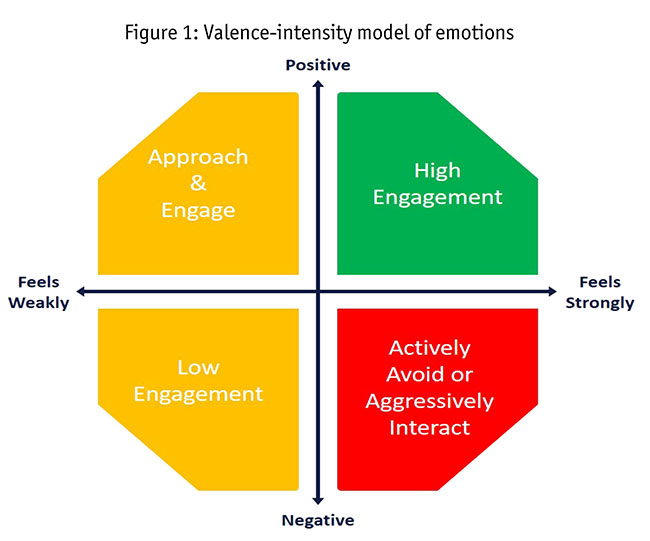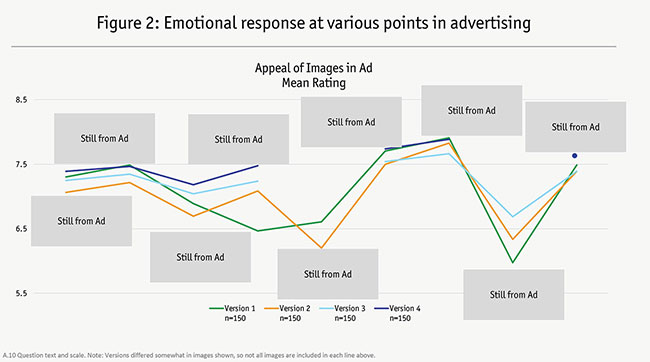Don’t think, just buy
Editor's note: Anne Beall is CEO of Beall Research Inc., Chicago. She can be reached at hello@beallrt.com.
 It’s a common belief in Western culture that we make better decisions when we take emotions out of the equation and rely on reason. In actuality, the reverse is true. We tend to make better decisions when emotions are involved. Fascinating research has been done in this area with people who have brain lesions that leave them with normal cognitive function but who lack the ability to process emotional signals. These people are the epitome of rational decision-makers because they can’t process any emotional information. Contrary to popular thought, researchers have found that these unemotional decision-makers actually make poor decisions or no decisions (Bechara 2004). These individuals, lacking emotion in their decision-making, have been known to bankrupt themselves or participate in other risky behavior because they don’t feel fear.
It’s a common belief in Western culture that we make better decisions when we take emotions out of the equation and rely on reason. In actuality, the reverse is true. We tend to make better decisions when emotions are involved. Fascinating research has been done in this area with people who have brain lesions that leave them with normal cognitive function but who lack the ability to process emotional signals. These people are the epitome of rational decision-makers because they can’t process any emotional information. Contrary to popular thought, researchers have found that these unemotional decision-makers actually make poor decisions or no decisions (Bechara 2004). These individuals, lacking emotion in their decision-making, have been known to bankrupt themselves or participate in other risky behavior because they don’t feel fear.
People use emotions as a gut check on whether to engage with brands, products, services and people. And this is particularly the case with advertising. Advertising creates an emotional response in humans who use that response to determine whether to interact further with that brand’s product or service offering.
The emotional system that humans use is a valence-intensity system in which we are drawn to engage with things that give a positive emotional response and avoid things that generate a negative one. Humans have emotional responses to most things that can vary from positive to neutral to negative and high to low intensity. Thus, one may have an intensely positive or negative response to a new product in a pop-up ad. If the reaction is a highly positive one, there is generally engagement. And if highly negative, there is typically avoidance. Figure 1 shows an overview of the model.

Consumers follow the lead of their emotions, which leads to a type of automatic “thinking” called System 1 thinking (Kahneman, 2013) that explains the survival of our ancient ancestors. They didn’t think much about whether a large creature was upset, how fast it could run or if it ate meat. They just felt fear and ran. That kind of quick, instinctive “thinking” still happens much of the time. Humans don’t have the ability to think deeply about everything they encounter. So, emotions guide decisions. You can probably see this in yourself when you encounter a new product in the store or see an ad. You immediately have a reaction to it: positive, negative or neutral, the intensity of your reaction determines whether or not you will engage with what you see.
Hard to resist
As a result of this basic system, emotions are strongly linked to behavior. When we experience strong emotions, we often feel compelled to behave in certain ways that can be hard to resist. When we’re sad, we withdraw; when happy, we engage; when angry, we fight. When we’re surprised, we open our eyes wider to evaluate our surroundings. As a result, understanding the emotional reactions triggered by brands, products and services allows us to understand consumer engagement (or lack thereof).
Another reason to understand emotions is because they’re linked to memory. Think about your life in retrospect and you’ll remember the highs and the lows. You won’t remember the regular days, probably due to an innate inclination to repeat positive emotional experiences and avoid negative ones. And, given that emotions are related to our ancestors’ survival, focusing on ways to manage these emotions makes sense. We’re hardwired to react to our emotions. Thus, humans are strongly motivated to engage in positive emotional experiences – whether that’s through interactions with people or through products and services. Thus, we’re likely to remember the people and companies that provide us with strong positive emotional experiences and engage with them more. The companies that give us negative emotional experiences will also be remembered and strongly avoided.
Most predictive emotions
We wanted to determine which emotions are most predictive of purchasing among current and potential customers. We conducted two large studies that included 17 major brands across many different consumer goods and retail categories to isolate the most predictive emotions. This research was conducted with approximately 2,000 respondents who represented the population of the United States. We analyzed the data and derived a statistical model that explains the majority of purchasing behavior (70 percent of the variance is accounted for with our model).
We learned that there are two major emotional experiences that are the most predictive of purchasing. The first is the emotional response to the brand – how it makes potential customers who haven’t used it feel and how it makes current customers who do use it feel. The second emotional predictor is emotional identification – how strongly respondents identify with it personally and see it as a representation of themselves. This model holds for both current and potential customers.
Same two factors
Communications that are emotional in nature perform better and lead to higher spending in the marketplace. For example, ads that have above-average emotionality are associated with a 23 percent lift in sales volume versus an average ad and, conversely, ads with below-average emotionality are associated with a 16 percent decline in sales volume (Forrester, 2017). But what emotions specifically? Our research indicates that it’s the same two factors that predict likelihood to buy: The emotional response to the advertisement and the degree of emotional identification are what makes ads effective.
We recently conducted both qualitative and quantitative research for a client on several different ads that it was considering for a new campaign. We first conducted focus groups where we identified the nature of the emotional response for each ad and the degree to which respondents said they identified with the brand in the ad. We plotted these scores real-time and then probed respondents on what aspects of each communication led to a positive or negative response and the intensity of that response. We also learned what aspects of the communication led people to experience emotional identification and what aspects didn’t. The model and this research clearly identified which ads were working best and why.
Our client used this feedback to select a potential campaign and to refine it. We then quantitatively tested several versions of this campaign with hundreds of respondents and calculated an emotional intensity score, emotional identification score and likelihood to purchase, in addition to traditional measures such as overall appeal of the communication, fit with brand, uniqueness of communication, believability, ease of understanding, relevance, unaided brand recall and message recall. The emotional significance score was highly predictive of likelihood to purchase – the more strongly respondents identified with a brand as a result of what they saw in the ad, the more likely they said they would be to purchase it.
We were also able to identify the emotional response to various points in each ad (see example in Figure 2), which helped the client determine what parts of the advertising were working, which characters were appealing and how the ad could be optimized. It was interesting to see which contexts and which individuals created the greatest emotional response. For example, nature scenes were consistently well-liked as well as certain popular celebrities.

We also collected traditional advertising measures and looked at the relationship of these measures to likelihood to purchase. With our emotional measures and the traditional ones, we conducted a driver analysis on all the data to determine what was most predictive of likelihood to buy. We learned that the most predictive variables that explained the majority of the decision to purchase are emotional identification and the emotional response to the advertising. Our work confirmed that people don’t think their way to a purchase decision, they feel their way to it. And the brands that create communications that trigger the strongest emotional response and identification are the ones that are most likely to be purchased.
References
Bechara, A. (2004). “The role of emotion in decision-making: Evidence from neurological patients with orbitofrontal damage.” Brain and Cognition, 55, 30-40.
Forrester, I. (2017). “The power of emotional advertising.” Affective.com. https://blog.affectiva.com/the-power-of-emotional-advertising
Kahneman, D. (2013). Thinking Fast and Slow. New York.
